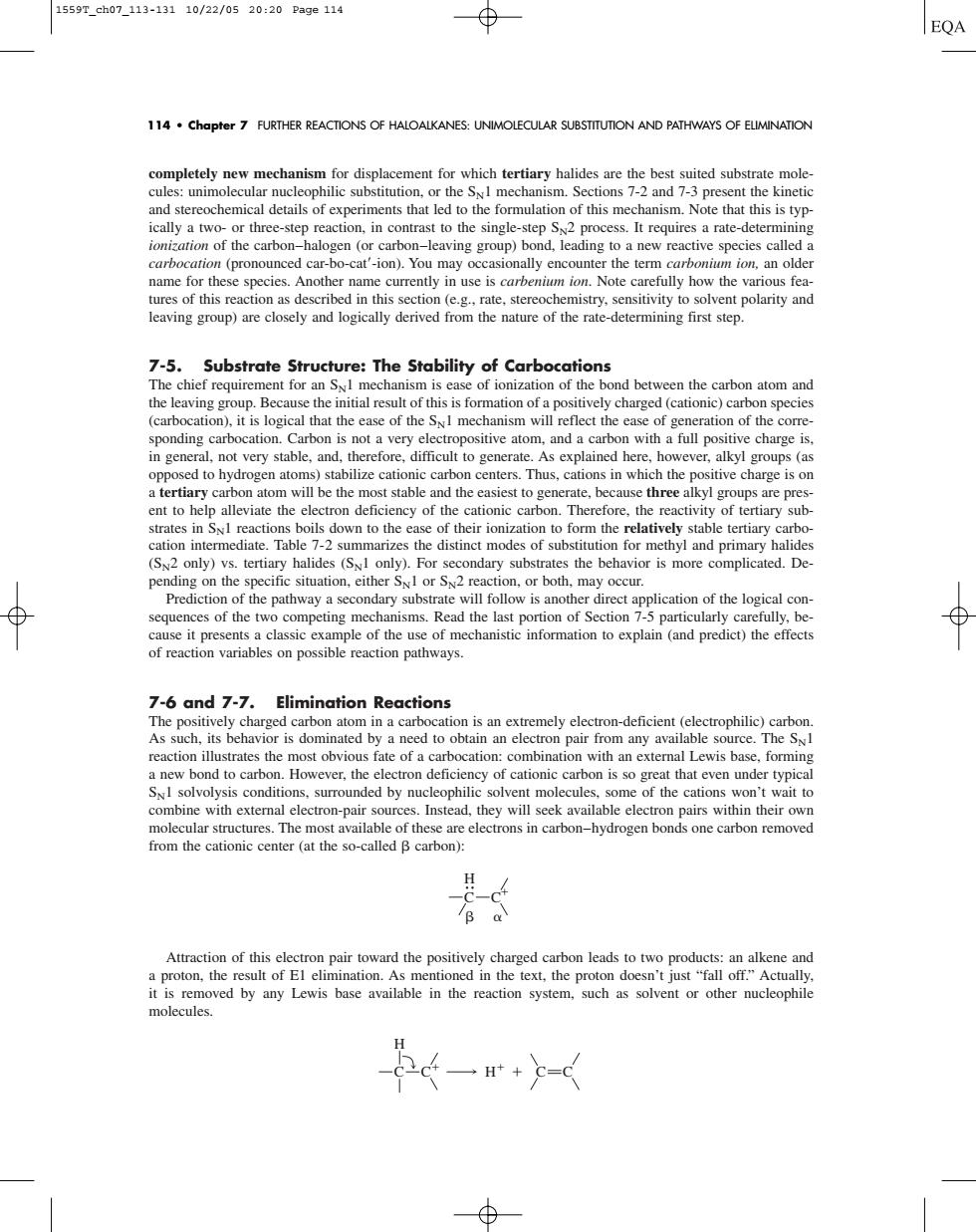正在加载图片...

15597ch07113-13110/22/0520:20Pag0114 EQA 114.chapter 7 FURTHER REACTONS OF HALOALKANES:UNIMOLECULAR SUBSTTTUTION AND PATHWAYS OF ELIMINATION completely new mechanism for displacement for which tertiary halides are the best suited substrate mole and st chemical details of experiments that led to the formulation of this mechanism.Note that this is typ ically a two-or three-step reaction,in contrast to the single-step S2 process.It requires a rate-determining alogen (o aving group) ng to a new reacuve species ca name for these eaving group)ar ely and logically 7-5.Substrate Structure:The Stability of Carbocations The chief requirement for anS mechanism isease of ionization of the bond between the carbon atom and gical isis formation spondine carbocation.Carbon is not a very elect positive atom.and a carbon with a full positive charge is alkyl groups (as a tertiary carbon atom will be the most stable and the easiest to generate.because three alkyl groups are pres. ent to help alleviate the electron deficiency of the cationic carbon.Therefore,the reactivity of tertiary sub n for methyl and p ary halide (S2 only)vs.tertiary halides (S only).For secondary substrates the behavior is more complicated.De- pen may occu lication of the logical c sequences of the two competing mechanisms.Read the last portion of Section7-5 particularly carefully,be- s on pos reaction pathways 7-6 and 7-7.Elimination Reactions The arbon atom in a carb e-deficient ()cabon is don nated by a need to n an elect on pair f om any aval source.Th a new bond to carbon However the electron deficiency of cationic carbon is so great that even under typica SyI solvolysis condi of the cation wait te Th e they wil from the cationic center (at the so-called B carbon): it is removed by any Lewis base available in the reaction system,such as solvent or other nucleophile molecules. 2c一H*+-ccompletely new mechanism for displacement for which tertiary halides are the best suited substrate molecules: unimolecular nucleophilic substitution, or the SN1 mechanism. Sections 7-2 and 7-3 present the kinetic and stereochemical details of experiments that led to the formulation of this mechanism. Note that this is typically a two- or three-step reaction, in contrast to the single-step SN2 process. It requires a rate-determining ionization of the carbon–halogen (or carbon–leaving group) bond, leading to a new reactive species called a carbocation (pronounced car-bo-cat-ion). You may occasionally encounter the term carbonium ion, an older name for these species. Another name currently in use is carbenium ion. Note carefully how the various features of this reaction as described in this section (e.g., rate, stereochemistry, sensitivity to solvent polarity and leaving group) are closely and logically derived from the nature of the rate-determining first step. 7-5. Substrate Structure: The Stability of Carbocations The chief requirement for an SN1 mechanism is ease of ionization of the bond between the carbon atom and the leaving group. Because the initial result of this is formation of a positively charged (cationic) carbon species (carbocation), it is logical that the ease of the SN1 mechanism will reflect the ease of generation of the corresponding carbocation. Carbon is not a very electropositive atom, and a carbon with a full positive charge is, in general, not very stable, and, therefore, difficult to generate. As explained here, however, alkyl groups (as opposed to hydrogen atoms) stabilize cationic carbon centers. Thus, cations in which the positive charge is on a tertiary carbon atom will be the most stable and the easiest to generate, because three alkyl groups are present to help alleviate the electron deficiency of the cationic carbon. Therefore, the reactivity of tertiary substrates in SN1 reactions boils down to the ease of their ionization to form the relatively stable tertiary carbocation intermediate. Table 7-2 summarizes the distinct modes of substitution for methyl and primary halides (SN2 only) vs. tertiary halides (SN1 only). For secondary substrates the behavior is more complicated. Depending on the specific situation, either SN1 or SN2 reaction, or both, may occur. Prediction of the pathway a secondary substrate will follow is another direct application of the logical consequences of the two competing mechanisms. Read the last portion of Section 7-5 particularly carefully, because it presents a classic example of the use of mechanistic information to explain (and predict) the effects of reaction variables on possible reaction pathways. 7-6 and 7-7. Elimination Reactions The positively charged carbon atom in a carbocation is an extremely electron-deficient (electrophilic) carbon. As such, its behavior is dominated by a need to obtain an electron pair from any available source. The SN1 reaction illustrates the most obvious fate of a carbocation: combination with an external Lewis base, forming a new bond to carbon. However, the electron deficiency of cationic carbon is so great that even under typical SN1 solvolysis conditions, surrounded by nucleophilic solvent molecules, some of the cations won’t wait to combine with external electron-pair sources. Instead, they will seek available electron pairs within their own molecular structures. The most available of these are electrons in carbon–hydrogen bonds one carbon removed from the cationic center (at the so-called carbon): Attraction of this electron pair toward the positively charged carbon leads to two products: an alkene and a proton, the result of E1 elimination. As mentioned in the text, the proton doesn’t just “fall off.” Actually, it is removed by any Lewis base available in the reaction system, such as solvent or other nucleophile molecules. H C H C C C H C C 114 • Chapter 7 FURTHER REACTIONS OF HALOALKANES: UNIMOLECULAR SUBSTITUTION AND PATHWAYS OF ELIMINATION 1559T_ch07_113-131 10/22/05 20:20 Page 114������